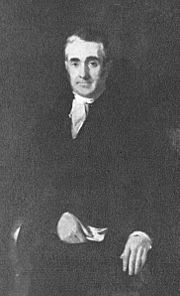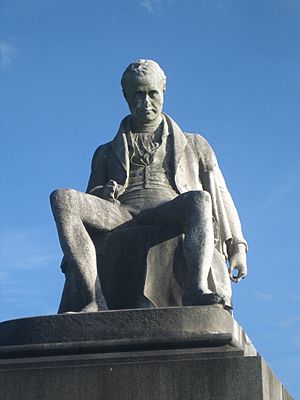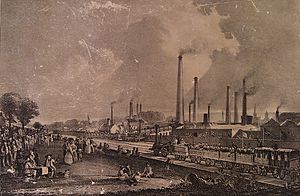Charles Tennant facts for kids
Quick facts for kids
Charles Tennant
|
|
|---|---|
 |
|
| Born | 3 May 1768 Laigh Corton, Alloway, Ayrshire, Scotland
|
| Died | 1 October 1838 (aged 70) |
| Occupation | Businessperson, chemist, industrialist |
| Parent(s) | John Tennant Margaret McClure |
| Family | Tennant |
Charles Tennant (born May 3, 1768 – died October 1, 1838) was a Scottish chemist and a very successful industrialist. He is famous for discovering bleaching powder. He also started a huge business empire that lasted for many years.
Contents
Early Life and New Ideas
Charles Tennant was born in a place called Laigh Corton, in Alloway, Scotland. He was one of thirteen children. His father was a farmer. Charles learned at home and at the local school. Later, he became an apprentice to a handloom weaver in Kilbarchan. He was even mentioned by the famous poet Robert Burns as "wabster (weaver) Charlie."
Charles was good at weaving. But he quickly saw a big problem. The way people bleached cloth back then was very slow. It involved using old urine and leaving cloth in the sun for months! This meant huge piles of unbleached cotton were waiting. Charles decided to leave weaving to find a faster way to bleach.
Inventing Better Bleaching
In 1788, Charles bought some land near Barrhead to try out his ideas. People had already found ways to make bleaching faster. They used sulfuric acid instead of sour milk. This cut the time from 18 months to just four. Bleachers also secretly used lime.
Charles had a brilliant idea. He thought that mixing chlorine with lime would work best. He worked on this for several years. Finally, he found a way that was effective, cheap, and safe. He received a patent for his method in 1798. He kept working and invented bleaching powder in 1799. This was a mixture of chlorine and dry slaked lime.
Starting a Business Empire
Around 1794, Charles teamed up with four friends. One of them was Charles Macintosh, a great chemist who also helped invent bleaching powder. He is known for making waterproof fabric.
After getting the patent for bleaching powder, Charles and his partners bought land near Glasgow. This area was called St. Rollox. They built a factory there to make bleaching liquid and powder. It was a good spot because lime was nearby, the land was cheap, and a canal offered easy transport.
The factory quickly became a huge success. In its first year (1799), it made 52 tons of product. By the fifth year, it made over 9,200 tons! Later, another factory was built, and by 1865, they were making 20,000 tons of bleaching powder.
Charles faced some challenges. Some people tried to copy his invention without paying. But despite these problems, his company grew very successful. When the original patents ended, Charles bought the whole company. By the 1830s and 1840s, his company was the biggest chemical plant in the world!
A Leader in Social Change
Charles Tennant was also a dedicated reformer. After the Napoleonic wars, many working-class people were poor. Charles and his son John worked hard for social change. They supported the Reform Bill of 1832, which helped more people have a say in government. This was a time when such ideas could be seen as dangerous. His efforts helped bring about a period of great social progress in Scotland.
Innovations in Transport
Even with all his other work, Charles never forgot his main business, the St. Rollox chemical works. By 1832, the factory used 30,000 tons of coal a year. The old transport system couldn't handle this.
Charles learned about a new way to move goods: wagons pulled by steam engines on iron rails. His friend George Stephenson, a famous railway engineer, told him about it. Charles quickly saw this was the answer for his factory. From 1825 until he died, he was a key person in building railways. He helped bring a railway into Glasgow, even though canal owners strongly opposed it.
He also saw the importance of waterways. In 1830, he helped his nephew William Sloan start a shipping business with small boats. This helped control the transport of his chemical products. By 1848, they had the largest fleet in Glasgow.
Charles Tennant's Legacy
Charles Tennant lived to see his business become one of the most important in the world. He was an amazing entrepreneur. He cared deeply about his work, his family, and doing what was right. He always helped those who were less fortunate. The changes he supported made life better for many people.
He died on October 1, 1838. His oldest son, John Tennant, took over the company for the next 40 years.
The Giant St. Rollox Plant
The St. Rollox plant in Glasgow became the world's largest chemical works in the 1830s and 1840s. It covered over 100 acres (about 0.4 square kilometers) and had a huge amount of floor space. More than a thousand people worked there, and it was very important to the local economy.
A giant chimney called the St. Rollox Stalk, or Tennant's Stalk, stood tall over everything. It was a famous landmark in Glasgow. Built in 1842, it was 435.5 feet (about 133 meters) high. At the time, it was the tallest chimney in the world. It was used every day until 1922, when it was hit by lightning and had to be taken down.
Family and Future
Charles Tennant is buried in Glasgow Necropolis. His business empire continued to grow. It expanded into explosives with Alfred Nobel, copper, sulfur, gold mines, and banking. His grandson, Charles Clow Tennant, became the first Baronet of Glenconner.
The chemical business Charles founded later became the United Alkali Company Ltd. In 1926, it joined with other companies to form a huge chemical company called Imperial Chemical Industries. Even today, a privately owned group called Tennants Consolidated Ltd. continues to trade chemicals around the world.
Notable Family Members

- Alexander Tennant (1772–1814) – Charles's brother
- Charles Clow Tennant (1823–1906) – Charles's grandson
- Edward Tennant, 1st Baron Glenconner (1859–1920) – Charles's great-grandson
- Margot Asquith (1864–1946) – Charles's great-granddaughter
- Harold Tennant (1865–1935) – Charles's great-grandson
- Edward Tennant (1897–1916) – Charles's great-great-grandson
- Elizabeth Bibesco (1897–1945) – Charles's great-great-granddaughter
- Anthony Asquith (1902–1968) – Charles's great-great-grandson
- Stephen Tennant (1906–1987) – Charles's great-great-grandson
- Simon Fraser, 15th Lord Lovat (1911–1995) – Charles's great-great-great-grandson
- Hugh Fraser (British politician) (1918–1984) – Charles's great-great-great-grandson
- Harold Tennyson, 4th Baron Tennyson (1919–1991) – Charles's great-great-great-grandson
- Charles Manners, 10th Duke of Rutland (1919–1999) – Charles's great-great-great-grandson
- Iain Tennant (1919–2006) – Charles's great-great-great-grandson
- David Fane, 15th Earl of Westmorland (1924–1993) – Charles's great-great-great-grandson
- Emma Tennant (b. 1937) – Charles's great-great-great-granddaughter
- Arthur Gore, 9th Earl of Arran (b. 1938) – Charles's great-great-great-great-grandson
- Torquhil Campbell, 13th Duke of Argyll (b. 1968) – Charles's great-great-great-great-great-grandson
- Stella Tennant (1970-2020) – Charles's great-great-great-great-granddaughter
- Honor Fraser (b. 1974) – Charles's great-great-great-great-great-granddaughter
Images for kids



